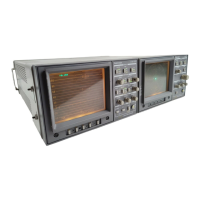1730–Series Theory of Operation
4–18
staircase signal, when RGB/YRGB operation is selected). The length of the
sweep, in RGB mode, is set by jumper J456 to accommodate either three- or
four-step sweeps (for RGB and YRGB modes).
U465A and U465B are comparators used to sense when the output of the
Magnifier and Position Amplifier have driven the CRT beam to the edge of the
CRT screen. When the beam is horizontally overdriven, the input to U234C is
pulled low to generate the BLANK enabling level for the Z-Axis Amplifier
(Diagram 6).
The Horizontal Output Amplifier is composed of Q858, Q860, Q862, and Q864,
with Q868 and Q865 serving as current source. R960 provides the differential
mode feedback; R958 and R959 provide the common mode feedback that biases
the outputs to approximately 50 volts. The gain of the amplifier is determined
by a voltage divider with two adjustments, R660 (Sweep Length Adj.), and
magnified sweep registration R661 (Mag Registration Adj.). In LINE SELECT,
Q762 and Q763 switch out the horizontal sweep and switch in the horizontal
X-Axis component of the line select readout.
Microcontroller
Diagram 5
The Microcontroller is the brain of the 1730-Series Waveform Monitor. It
monitors the front panel, Store/Recall functions, and the Remote interface.
Changes to any switch setting or remote line is converted into appropriate
control levels for circuits in the rest of the monitor.
The 8052 Microprocessor (U522), used as the 1730-Series Microcontroller,
contains 8K of masked ROM. The on-board masked ROM holds the Micropro-
cessor machine instructions. Crystal-controlled oscillator frequency is 12 MHz.
The processor operates with an eight-bit multiplexed address/data bus that
interfaces through Port 0 (pins 32-39). Front-panel switches and Recall
selections are sensed by Port 1 (pins 1-8). Each front-panel momentary contact
switch (along with the Recall switches) has a specific row and column address.
Functions are changed by simply pushing (to toggle) or pushing and holding a
front-panel momentary contact switch. As an example: When row 1 and
column 1 are connected together (by switch closure) the sweep rate toggles
between the 2-line and 2-field sweep rate; however, if the switch is held in for a
discernible interval the processor will switch sweep rate to 1 line.
The I/O Port 2 provides eight additional interface lines. Three lines communi-
cate with the NOVRAM (Clock-pin 21, Data-pin 22, and Chip Enable-pin 23).
Four lines (pins 25-28) output high levels to drive analog switching functions
Horizontal Output
Amplifier
Microprocessor

